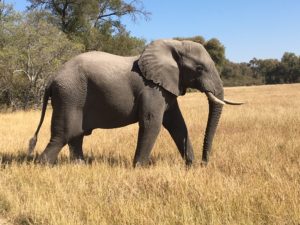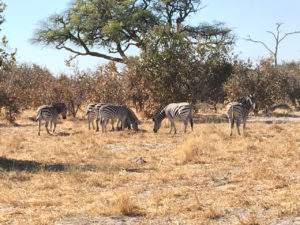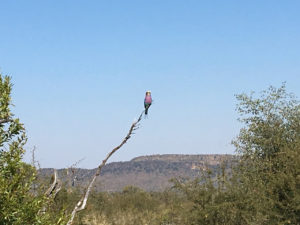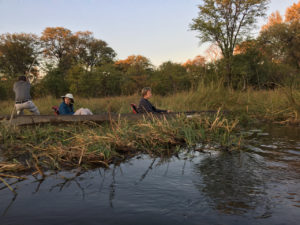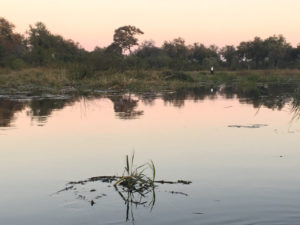Some people think of Africa as a continent populated by dark skinned people who have adapted to living in a very hot climate. They have not been to Southern Africa in July. Today as I climbed into our 4 wheel drive vehicle in the Khwai Concession Area in the Okavango Delta Area of Northern Botswana, I was wearing, from inside out, a wool long-sleeved shirt, a long-sleeved nylon blouse, a Patagonia Nano-Puff insulated jacket, a down filled jacket, a nylon wind breaker, a wool beret and fleece gloves. And I was still cold when we started down the dirt road at 7 am and so put on a nylon and fleece poncho provided in the vehicle and further covered myself with a wool blanket. Richard and Hedy were similarly attired and we all looked like well-padded creatures out in the arctic.
We are really in the bush here at the Khwai Guest House — no electricity except solar power for lights and heated water. When we flew out of Maun in a single-engine 8-seater prop plane, we saw brown circles and ovals encircled with green trees and I was told these were traditional bomas, made to hold cattle for individual farmers. As we flew along, below us were large swathes of brown fields dotted with green foliage. Further on were sunlit ribbons of rivers which expanded to include ponds and water holes of this marshy area as we flew lower before alighting on our dirt airstrip. At the end of the single runway stood an elephant to welcome us. There was nothing else around except silence and the vehicle that had come to pick us up.
Our individual huts are wonderful — with thatched roof and concrete walls and a beautiful screened in bathroom with a good shower. We eat outside under an open air outdoor structure and the food is quite good. They have stretched their menu to include vegan options for me at every meal but I am glad I brought my organic peanut butter as what they have here is the African Skippy version with sugar, salt and various other additives. And there is no internet or even cell phone connection available. We must all talk to each others and at the moment there are 8 other interesting people: 2 Danes, 1 New Zealander, and an English family of 5.
In the Madikwe preserve in South Africa, all guides carried rifles and there were seat belts in all vehicles: here there is a more relaxed attitude. No guns, no seatbelts, and a more aggressive attitude toward tracking the animals. Our guide is Ninja, a local man, who is a fabulous driver, does not hesitate to take our Land Rover right into the middle of a thicket of trees and grasses or through fairly deep water to follow some moving creature. We have seen hippos, zebras, giraffes, elephants, warthogs, red lechwe, spotted hyenas, narrow-striped mongoose, broad- banded mongoose, African painted wild dogs, wildebeest, impala by the scores (you see them standing still for a moment when they spot you and then they suddenly run and jump together as a herd at great speed), steenbok, waterbuck, kudu, African hares, crocodiles, a monitor, rock python, African squirrels, and even an elusive leopard walking across the road.
There are numerous birds which Richard can spot and name and he says that we saw the lilac-breasted roller (Richard’s favorite with brilliant turquoise spread wings), the little bee eater (my favorite with orange breast and green head), woodland green hoopoes, jacana, African fish eagle (a large majestic bird), pied kingfisher, yellow hornbill, malachite kingfisher, starlings, forked-tailed drongo, black-shouldered kite (who hovered a long time the air in one place), saddle-beaked stork, and open-billed stork.
Our Big African Adventure happened this afternoon when we went out with other people on makoros (small fibreglass boats, originally wooden canoes), two passengers plus the guide per boat, along a small tributary of the Khwai River. Filled with grasses and water plants of many sorts (including African water lilly) we were poled along by our standing boatmen, being shown many kinds of birds and plants along the way. Suddenly we came to an open water area in which was submerged a large hippopotamus and we could go no further as the hippo is considered one of the most dangerous animal in Africa once angered. We watched him submerge and then lift his nostrils out to breath air every 6-7 minutes or so. Then we turned around and headed back for a tea break at a small beach area. But as we were packing up to leave, another hippo appeared in the middle of the path to our exit. Now what to do! We quietly watched from the side, hoping she would swim past us to her mate. Meanwhile it is getting dark and we need to get out of the river area as it becomes dangerous at night so the leader decides we are to quietly row around the side of the hippo through the weeds to make our escape. And so we do, our five boats in single file, paddling in total silence and making as little motion as possible. Whew! We are back to where we entered the water and find our vehicle to bring us back to our welcoming camp.
Another evening with campfire and dinner under our canvas lounge area, good company and an interesting tale to tell.



